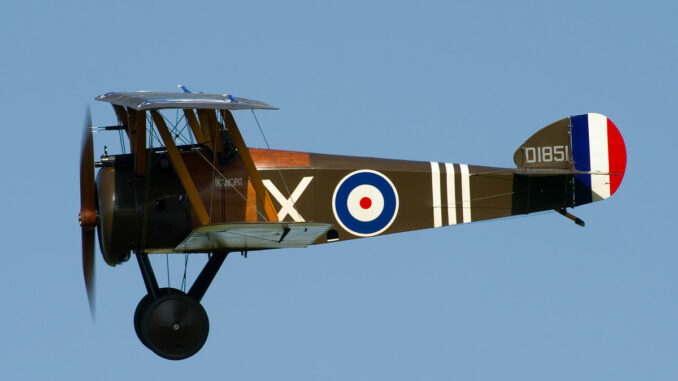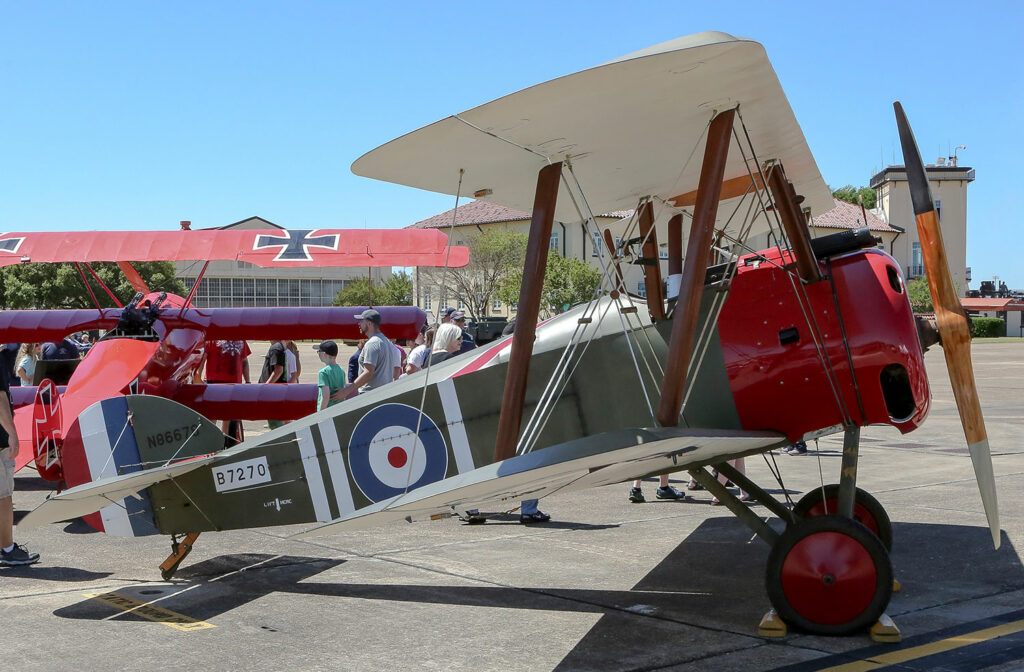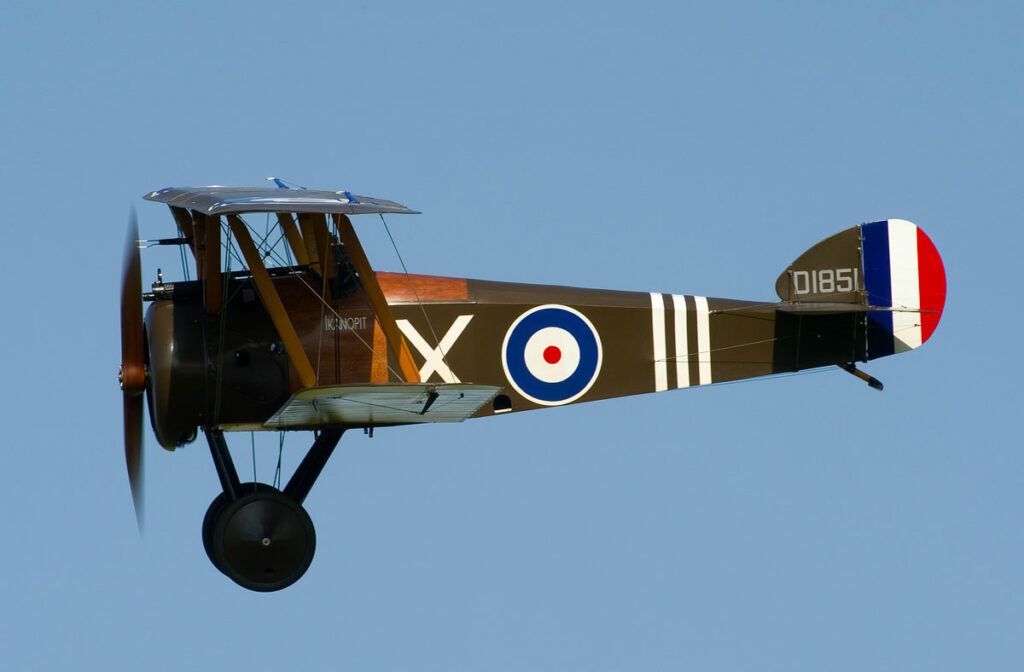
The Sopwith Camel stands out as one of the most iconic aircraft of World War I, playing a pivotal role in reshaping aerial combat and securing air superiority for the Allies. Introduced in 1917 by the Sopwith Aviation Company, the Camel quickly gained a reputation for its agility, firepower, and effectiveness in the hands of skilled pilots. Its contributions to the war effort were instrumental in establishing the dominance of air power as an essential component of military strategy.
The Sopwith Aviation Company was founded by Thomas Octave Murdoch Sopwith in 1912. An accomplished pilot and aviation pioneer, Sopwith played a crucial role in advancing aircraft design during the early 20th century. His passion for aviation and innovative spirit laid the foundation for the company, which would go on to produce some of the most celebrated aircraft of World War I, including the legendary Sopwith Camel.
Design and Performance
The revolutionary design of the Sopwith Camel made it a formidable force in the skies. It featured a compact wooden and fabric frame powered by a rotary engine, lending it exceptional manoeuvrability. The Camel’s twin Vickers machine guns, synchronised to fire through the propeller, offered deadly firepower that gave pilots a crucial advantage during dogfights. However, this aircraft was not without its challenges. Its design created a pronounced torque effect, making it difficult for inexperienced pilots to handle. This unforgiving nature earned it both fear and respect, as those who mastered the Camel were capable of extraordinary feats in air combat.

Aerial Supremacy and Achievements
The Sopwith Camel played a significant role in securing aerial supremacy for the Allies. By the end of the war, it had been credited with more enemy kills than any other Allied aircraft, boasting a tally of nearly 1,300 victories. The plane was instrumental in defending against German aircraft and supporting ground operations by providing close air support and reconnaissance. Its presence in major battles, such as the Battle of Cambrai, underscored its versatility and importance.
Technical Comparison of Performance
The Sopwith Camel’s performance set it apart from many other aircraft of its era, particularly in terms of manoeuvrability and firepower. Equipped with a powerful Clerget 9B rotary engine producing 130 horsepower, the Camel boasted a top speed of approximately 115 mph (185 km/h) and an impressive climb rate of 5,000 feet in under five minutes. Its twin synchronized Vickers machine guns provided unmatched offensive capability at the time. Compared to contemporaries like the Albatros D.V used by the German Luftstreitkräfte, the Camel excelled in turns thanks to its unique centre of gravity and forward weight distribution, allowing pilots to perform tight manoeuvres critical in dogfights. However, the same handling traits that made it lethal in combat also rendered it difficult to control, particularly for inexperienced pilots. Despite this, the Camel’s combination of agility, speed, and firepower often gave it an advantage over rival aircraft in skilled hands, contributing significantly to its reputation as one of World War I’s dominant fighters.
The Sopwith Camel played a pivotal role in numerous aerial missions and battles during World War I, amassing an impressive record of over 1,200 confirmed kills. Its primary role was as a fighter aircraft, often assigned to patrol-friendly skies and intercept enemy reconnaissance planes and bombers. The Camel excelled in dogfights, its manoeuvrability allowing skilled pilots to evade enemy fire while targeting German aircraft such as the Albatros and Fokker Dr.I. It was also used effectively for ground attack missions, strafing enemy trenches and disrupting supply lines with machine gun fire and small bombs. The aircraft became a mainstay of the Royal Flying Corps and later the Royal Air Force, particularly during pivotal air campaigns like the Battles of Arras and Cambrai. Its involvement in maintaining aerial superiority made it a crucial tool for Allied forces, shaping the dynamics of air combat during the war.
Challenges and Legacy
While the Sopwith Camel was undeniably a powerful tool of war, it also came with steep learning curves. Its demanding handling characteristics resulted in numerous accidents during training missions, highlighting the intense skill required to pilot it effectively. Despite this, the Camel’s successes far outweighed its difficulties. Its influence laid the groundwork for future advancements in fighter aircraft design and solidified the role of air combat in modern warfare.

The Camel’s Place in History
Today, the Sopwith Camel is remembered as a symbol of innovation and bravery during World War I. It exemplifies how technology and human ingenuity can adapt to the demands of warfare, transforming the battlefield and shaping history. From its remarkable performance during combat to its lasting impact on aviation, the Camel remains one of the most celebrated aircraft of its time. Its legacy reminds us of the critical role air power played in achieving victory during World War I and beyond.
Where to See the Sopwith Camel Today
For aviation enthusiasts and history buffs, the Sopwith Camel can be viewed in several museums around the world. One notable location is the Royal Air Force Museum in London, UK, where a well-preserved Sopwith Camel is on display, providing visitors with an up-close look at this iconic aircraft. Additionally, the National Museum of the United States Air Force in Ohio, USA, also features a Sopwith Camel among its exhibits. Other locations, such as the Canada Aviation and Space Museum in Ottawa, Canada, and the Musée de l’Air et de l’Espace in Paris, France, may house replicas or original models of the aircraft. These institutions help preserve the legacy of the Sopwith Camel, allowing visitors to explore its history and understand its significant contribution to World War I aviation.
War Wings Daily is an independant magazine.